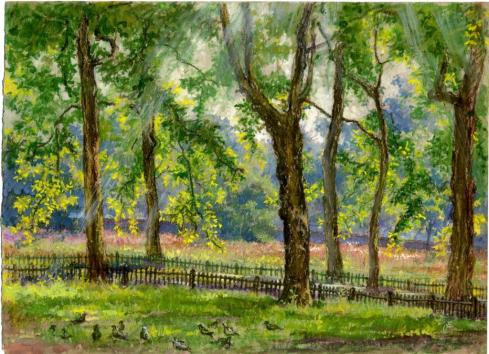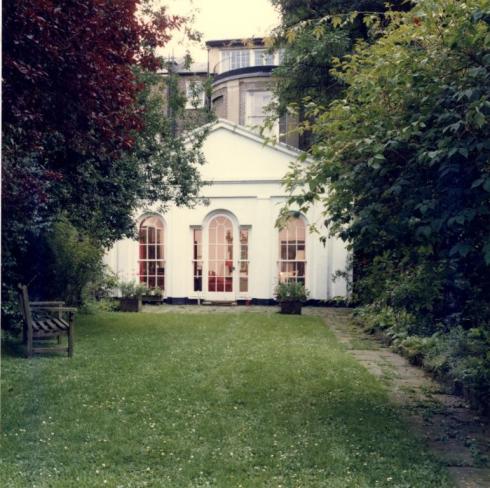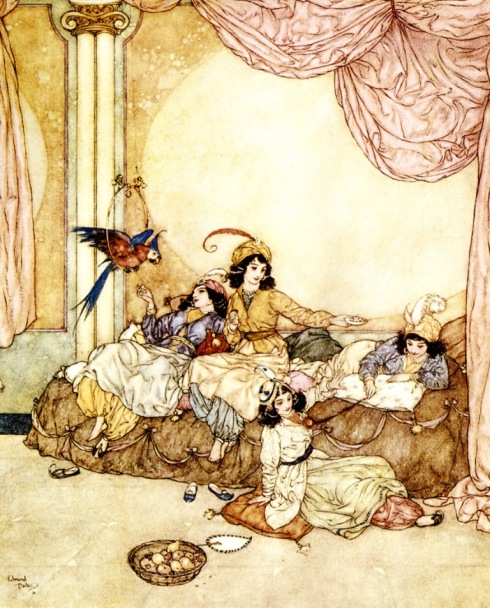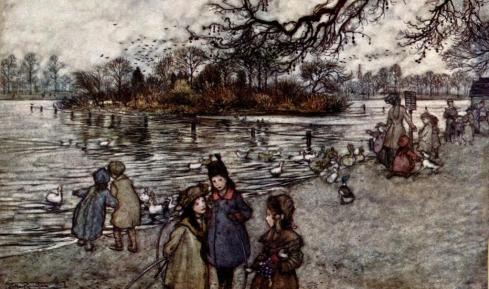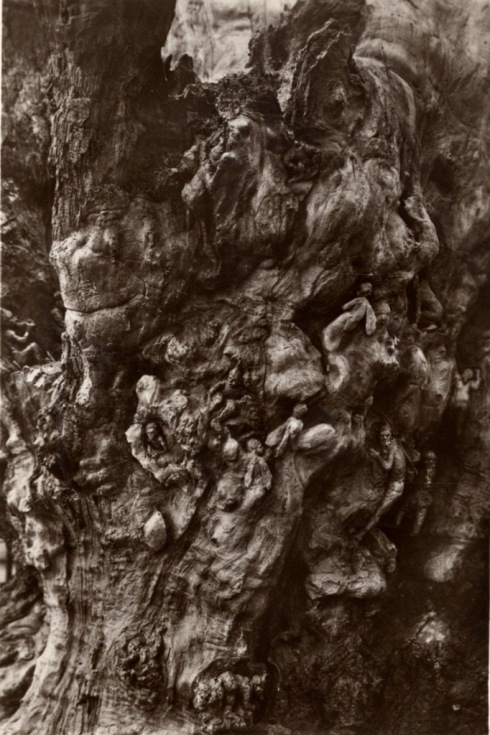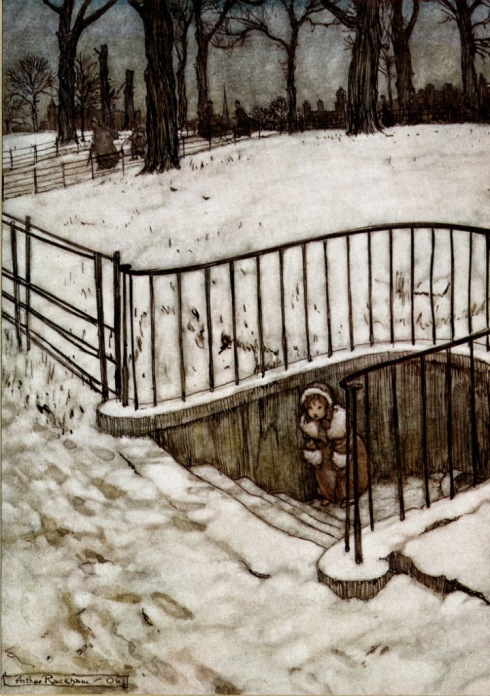My friend, colleague and occasional co-blogger Isabel Hernandez has been promising me a post for weeks but has been suffering from creative difficulties. To solve the problem she turned to a different topic and surprised me with this charming piece.
“Shall I tell you something about some of the little people who live in the Elfin Oak?”
Something about childhood and summer days triggered my interest in the Elfin Oak recently. In looking for something the other day, I came across a little inconspicuous book by Elsie Innes called, The Elfin Oak of Kensington Gardens, which she wrote in 1930. The author is, of course, the wife of the artist Ivor Innes. The man who sculpted the animal and fairy figures of this well-known feature found by the Princess Diana children’s playground, near the Bayswater end of the Broad Walk. If you ever wondered about the story behind all those little figures, including their names, this is where she imaginatively gives them life. I had no idea this existed, but then I guess I always had my own inklings as a child as to who they are. I don’t say ‘were’ because thanks to two major restorations over the decades, these little figures are preserved and continue to delight children and adults alike. A little more about that later.
Before I show you some of the lovely illustrations from the book I thought I would give you a little background as to the origins of this marvelous park artifact. I’m sure many of you are familiar with the hollowed out oak log. To some it was a mystifying object, but not so out of place that it doesn’t almost compliment that other familiar feature, Peter Pan. It is said that Kensington Gardens is home to the fairy folk. And why not? London’s Parks have a history that goes way back before we inhabited them. Once upon a time this was all ancient woodland.
Below is an image taken in 1967. It is important to note that the Elfin Oak is not a native of Kensington Gardens. This ancient oak was originally brought from Richmond Park in response to an appeal to improve facilities in the Royal parks – the Lansbury Appeal. It was unveiled in 1930 by the Mayoress of Kensington, Mrs Robinson, as reported in the Kensington News.
Its age varies according to whatever source you’re reading. In researching this I came across several different estimates: from 100 years to 1000 years. Many fanciful journalists I would imagine, in some reports, just made it up. Yet perhaps nobody really has a definitive answer. If I had to bet on the age (I did always wonder), I think perhaps it is between 400-600 years of age, but I’m no expert. That’s my fanciful notion. Trees are wonderfully long-lived and oaks have been venerated throughout history as being strong and durable. Another interesting tree fact about Kensington Gardens is that few old oaks remaining in the park are pre-1850. Many of the oaks you see today were planted since.
Below, taken a little earlier (1966), the half-tree trunk looks a little worse for wear, but in actuality this was probably post restoration which was undertaken by the late comedian, Spike Milligan. He is largely responsible for the campaign to keep the Elfin Oak preserved on two occasions. In the early 1960’s he was so shocked by the deteriorating condition of the tree that he undertook the repairs and restoration of the oak stump and its little figures at his own expense. Later in the 1990’s he led a campaign to raise money to restore it again and succeeded:
“We spent two years restoring the tree. That was 30 years ago. Alas it got into a sorry state again and needed attention to ensure its permanent survival.” After thanking his various contributors, he adds, “So there is now hope for the wee folk of England.”
Note the huge slide in the background. Something of a health & safety nightmare these days, but I do recall a few bumps and bruises after playground visits occasionally.
The black and white photographs do not do the sculpted figures justice as their colour is obviously muted, but the gnarled knots and twists within the oak itself probably look more contoured in black and white.
The tree is comprised of fantastical creatures: gnomes, elves, witches and animals of the forest. They all have a story. The plaque by the tree reads:
“Originally carved in 1911 and maintained for over 40 years by sculptor Ivor Innes.” He carved out his creations by chipping and scraping the distortions of growth and grain. And yet there came a point eventually in the years afterwards when the little figures began to look a little shabby and neglected. The oak log itself was reconditioned to stave off the onslaught of insects feeding off the dead wood. It was given a coating of creosote, a kind of wood tar, its branches were covered with lead and blackened, and the base of the tree was given a concrete floor. But the sculpted figures were also in desperate need of attention. Every few years they were painted, but the ravages of time took their toll.
If you’re wondering why the Elfin Oak is in a cage it is probably partly because soon after renovations took place in 1966, it was discovered that the fairy king had gone missing. A little bell which Spike Milligan had found in the ruins of Knightsbridge barracks and included, had gone too. Either a theft had taken place or the fairy king decided he needed to go and attend to affairs elsewhere with a bell, and gone gallivanting. The cage in actuality is a protective addition.
In colour the tree stump and figures look a lot more cheerful. Also this was post renovation. A huge difference to what it looked like before it was lovingly restored.
So who are these little figures? The illustrations below are all the work of Ivor Innes. His talent was not confined to sculpture. As you will see below, he really did have a flair for illustration too. I really think they are rather charming and I will now let Elsie tell you who they are in her own quaint, inimitable way…
“High up in the tree is a little old witch. She is Wookey. She has three large jars of magic potion – one red – one yellow – and one blue. The red brings health, the yellow wealth, and the blue happiness.”
“And everyone wants some of the most precious potion of all, from the blue jar, for that brings great happiness, such as love, sunny hours, merry thoughts, and sweet memories”
“Down in a hollow in the old tree trunk lives a little grey woman, Mother Cinders.”
“Nearby is the Gnomes’ Stairway, going up the steep side of the old trunk. At the top under the arch is Huckleberry, a strong little fellow, carrying a heavy sack of fresh berries for the feast of the king of the gnomes. And halfway up the steps is Nimble Toes climbing over an awkward knobbly ledge. Just below him, Russet is resting his sack of acorn flour. And lower down still, just beginning to climb, is the Dew Carrier, with his little pail strapped to his back.”
“It is usually very, very difficult to see fairies and they do not often show themselves to prying eyes. A dainty wee fairy is on a ledge of the old oak tree. She is Harebell.”
“Here is Dandy-Puff, a little imp dressed in yellow; Pointed Ear, an elf in green, clinging under the ledge; Hideaway, in the shade below; and Snuggles, a pixy peeping out from the corner edge. The Little People call all this part of the tree Sunny Corner.”
“On an outstanding branch of the oak the Green Woodpecker has pecked at the hard wood with his strong beak.”
“Sly Fox is curled up close beside a rabbit hole, fast asleep, but the fat little bunnies are afraid to venture out.”
“Up at the very top of the tree a raid on the Crow’s nest has been going on. The pixies have just succeeded in getting an egg. On Midsummer Day the fairies hold a special Revelry. You hear them in the rippling brooks; you feel them in the passing breeze; and you see them in the moonlight when night brings the full moon, and they dance and sway in fairy rings to ravishing elfin music, or they frolic and gambol and float in misty wreaths on the hillsides.”
“Hidden away in the roots of the tree, you may discover the Leprechauns’ Crock of Gold, near where two little mice are scampering about. Do not touch the fairy gold, or try to steal it, for it will only turn to dead leaves if you do, and luck will always be against you.”
“The Brown Owl looks out from his favourite nook. He is the colour of the tree itself that he is at first difficult to notice. He and the White Barn Owl above him always share in the night revelry of the Little People, swooping and flitting silently round the tree whilst the feasting is in progress.”
“Between these two wise owls there is a little man poring over a very large book. He is Quips, and he keeps the records, and writes the Fairy Lore. Every wise saying and doing of the elfin folk is recorded by Quips. So now you know how Fairy Tales come to be written.”
“There is one more creature who has made a home for himself in the Elfin Oak. He is the Wild Brown Rabbit, friend of all the fairy folk; his long ears are quick to hear the slightest sound, and if danger approaches the stamp, stamp of his strong hind foot is heard on the ground, the warning signal for all the little people to get into hiding.”
“It is at night after the playground has closed that the feasts are prepared; the fairies dance, and the pipers play, and the owls wake up, and all the little elves and brownies, gnomes and pixies, leave their hiding-holes and play and dance in the moonlight round the Old Elfin Oak.”
Should you happen to take a stroll through Kensington Gardens at any point with a little time to spare, go and take a look at the Elfin Oak. It has been a few years since I visited Ivor Innes’ whimsical creation, but I’m pleased to say that my enthusiasm for the old tree has not dissipated with age. In fact, part of me still clings to that imaginative lore of old. However you fashion myths and fairy tales, there is always a way to tell the story. The Elfin Oak is simply an interpretation of somebody’s vision of a fairy tale. It may appear a little dated now, but it remains unique, and like Peter Pan, it will never really grow old with new generations always discovering it for the first time.
Postscript by DW
Isabel has done me a favour by having this week’s post ready to go. The fact that the subject has no connection with the terrible events of last week is fortunate. Last week I felt it was inappropriate to post anything in the face of the massive trauma suffered by the people of North Kensington. But is it any better to carry on after a respectful silence? Remember, I work for the Royal Borough of Kensington and Chelsea so it’s also inappropriate for me to enter into any controversy. So let me just say this.
It is clear that the Grenfell Tower fire is a major event in the history of this borough which will not be forgotten by anyone who lives or works in this area or in the rest of London.
The day after the fire we were asked by a newspaper for a picture of the tower. We couldn’t find one initially. There are always things you can’t find and the Lancaster West Estate doesn’t seem to have been photographed very much by us. But I did finally think of somewhere we hadn’t looked and found a couple of images from 1983, probably taken by someone in the planning department. Here is one of them with Grenfell Tower in the centre, with (left to right) Frinstead, Markland, Dixon and Whitstable
Any image of the old tower now looks poignant.
This is usually a quiet time of year for the blog. People have other things to do in the summer. But since last Wednesday page views have shot up and North Kensington topics are the most popular. I hope readers are finding something positive in these snapshots of history. So we’re going to continue posting. As it happens I was intending to do a post on the artist Herbert Railton, followed by a series of posts based on a recent donation, a collection of photographs of Chelsea, which will fascinate those of you who are interested in the area. But that doesn’t mean I or my team are ignoring the north of the borough or trying to forget. That could never happen. I have lived and worked in the borough for more more than thirty years. Isabel lived in North Paddington for a similar period. For both of us this part of London is our home.















































































